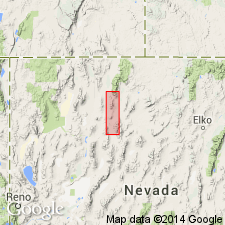
- Usage in publication:
-
- Auld Lang Syne Group*
- Modifications:
-
- Named
- Dominant lithology:
-
- Shale
- Sandstone
- AAPG geologic province:
-
- Great Basin province
Summary:
Named for Auld Lang Syne Peak. Type section is section in north part of East Range from SW/4 sec. 32 T23N R37E to sec. 24-23 T34N R36E, Rose Creek 7.5' quad, Pershing Co., NV. Reference section at sec. 6 T40N R39E to sec. 7 T41N R38E, south Santa Rosa Range, Paradise Valley 15' quad, Humboldt Co., NV. Consists of (ascending): previously defined Grass Valley, Osobb, Dun Glen, Winnemucca, O'Neill, Raspberry, Singas, Andorno, and Mullinix Formations. Constitutes continuous succession of variably metamorphosed, interlensing, argillaceous and sandy strata with subordinate limestone and dolomite that were derived from east source area and seemingly deposited in shallow marine, deltaic environment. Is 25,000 ft thick. Overlies Star Peak Group; unconformably underlies Tertiary volcanic rocks. Is Late Triassic and Jurassic(?) age.
Source: GNU records (USGS DDS-6; Menlo GNULEX).

- Usage in publication:
-
- Auld Lang Syne Group*
- Modifications:
-
- Age modified
- Areal extent
- AAPG geologic province:
-
- Great Basin province
Summary:
Auld Lang Syne Group, undivided, geographically extended into western Pershing County, northwestern Nevada. In eastern part of Pershing County the Osobb, Grass Valley, Dun Glen, Winnemucca, and Raspberry Formations are exposed. Age is changed from Late Triassic and Jurassic(?) --to-- Late Triassic and Early Jurassic.
Source: Changes in stratigraphic nomenclature, 1978 (USGS Bull. 1482-A, p. A4); GNU records (USGS DDS-6; Menlo GNULEX).
- Usage in publication:
-
- Auld Lang Syne Group*
- Modifications:
-
- Overview
- AAPG geologic province:
-
- Great Basin province
Lupe, R.D., and Silberling, N.J., 1985, Genetic relationship between lower Mesozoic continental strata of the Colorado Plateau and marine strata of the western Great Basin; significance for accretionary history of Cordilleran lithotectonic terranes: Circum-Pacific Council for Energy and Mineral Resources Earth Science Series, v. 1, p. 263-271., Presented at GSA 92nd Ann. Mtg., San Diego, CA, November 5-8, 1979; GSA Abs. Prog., v. 11, no. 7, p. 470
Summary:
Three major influxes of fine-grained terrigenous clastic sediments from an eastern source are recorded in marine Norian (Upper Triassic) and Hettangian (Lower Jurassic) Auld Lang Syne Group of northwest NV. These cycles may correspond to major cycles of fluvial deposition in Chinle Formation 500 km to east. If this relationship is correct, age of Chinle would be late Karnian, Norian, and Hettangian, or Late Triassic and Early Jurassic.
Source: GNU records (USGS DDS-6; Menlo GNULEX).
For more information, please contact Nancy Stamm, Geologic Names Committee Secretary.
Asterisk (*) indicates published by U.S. Geological Survey authors.
"No current usage" (†) implies that a name has been abandoned or has fallen into disuse. Former usage and, if known, replacement name given in parentheses ( ).
Slash (/) indicates name conflicts with nomenclatural guidelines (CSN, 1933; ACSN, 1961, 1970; NACSN, 1983, 2005, 2021). May be explained within brackets ([ ]).

